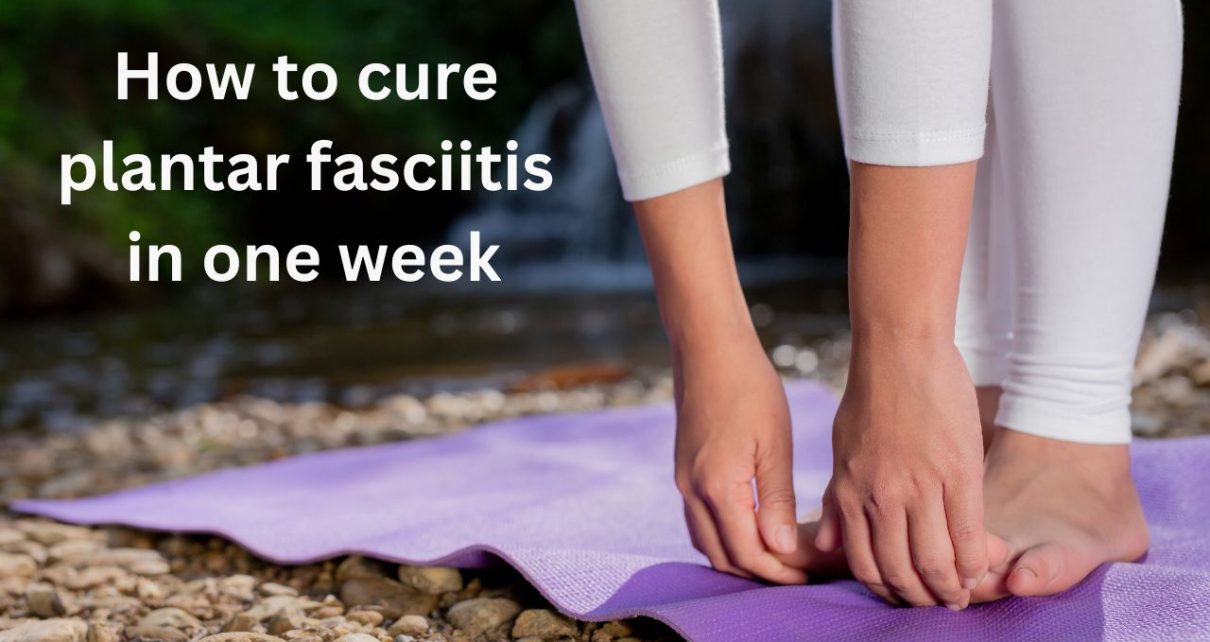Plantar fasciitis is a common and often painful condition that affects the heel and bottom of the foot. It is caused by the inflammation of the plantar fascia, a thick band of tissue that connects the heel bone to the toes, providing support to the arch of the foot. This condition can be quite debilitating, making it difficult to walk or engage in everyday activities. While complete resolution of plantar fasciitis within one week may be challenging, there are several measures you can take to alleviate the pain and promote healing.
By adopting a comprehensive approach that includes rest, targeted exercises, proper footwear, and other treatment options, you can significantly improve your symptoms and speed up the recovery process. In this article, we will explore some effective strategies to manage how to cure plantar fasciitis in one week and help you find relief from the discomfort associated with this condition.
Table of Contents
What is plantar fasciitis?
Plantar fasciitis is a condition characterised by inflammation and irritation of the plantar fascia, a thick band of tissue that runs along the bottom of the foot. The plantar fascia connects the heel bone to the toes and provides support to the arch of the foot.
What are the symptoms of plantar fasciitis?
The symptoms of plantar fasciitis typically manifest in the foot and heel area. Here are the common symptoms associated with this condition:
Heel Pain
The primary symptom of plantar fasciitis is pain in the heel. It is usually felt as a sharp or stabbing sensation, which is often worse in the morning when taking the first few steps or after periods of rest. The pain may also increase after prolonged standing, walking, or physical activity.
Foot Arch Discomfort
Some individuals with plantar fasciitis may experience pain or discomfort in the arch of the foot, as the plantar fascia extends from the heel to the ball of the foot.
Tenderness
The affected area may feel tender to the touch, particularly around the inside of the heel where the plantar fascia attaches to the bone.
Stiffness
People with plantar fasciitis may experience stiffness and reduced flexibility in the foot, making it challenging to bend the foot upwards or stand on tiptoes.
Gradual Onset
The symptoms of plantar fasciitis often develop gradually over time, rather than appearing suddenly.
What causes plantar fasciitis?
Plantar fasciitis is commonly caused by repetitive strain and excessive stress on the plantar fascia, leading to inflammation and micro-tears in the tissue. The exact cause of plantar fasciitis may vary from person to person, but there are several factors that can contribute to its development. These include:
Overuse or Overactivity: Engaging in activities that involve repetitive stress on the feet, such as running, jumping, or standing for long periods, can strain the plantar fascia and lead to its inflammation.
Foot Mechanics: Certain foot mechanics or abnormalities can increase the risk of developing plantar fasciitis. These include having flat feet, high arches, or an abnormal walking pattern that places excessive pressure on the plantar fascia.
Improper Footwear: Wearing shoes that lack proper arch support, cushioning, or stability can contribute to the development of plantar fasciitis. Additionally, sudden changes in footwear, such as switching to high heels or unsupportive shoes, can strain the plantar fascia.
Weight and Body Mass Index (BMI): Excess weight can put additional stress on the plantar fascia, increasing the likelihood of inflammation and pain.
Age: Plantar fasciitis is more common in middle-aged individuals, as the flexibility and elasticity of the plantar fascia tend to decrease with age.
Occupational Factors: Certain professions or activities that require prolonged periods of standing or walking on hard surfaces, such as factory workers, teachers, or athletes, can increase the risk of plantar fasciitis.
Tight Muscles and Poor Flexibility: Tight calf muscles and a lack of flexibility in the ankle can contribute to plantar fasciitis by placing excessive strain on the plantar fascia.
How to prevent plantar fasciitis?
Here are some preventive measures to consider:
- Wear supportive footwear
Choose shoes that provide proper arch support, cushioning, and shock absorption. Avoid high heels, unsupportive flats, and worn-out shoes. Consider using orthotic inserts or arch supports if needed.
- Gradual increase in activity
When starting a new exercise or activity routine, gradually increase the intensity and duration to allow your feet and plantar fascia to adapt to the stress.
- Stretch regularly
Perform stretching exercises for your calf muscles, Achilles tendon, and the plantar fascia itself. Stretching helps maintain flexibility and reduce tension in these areas.
- Maintain a healthy weight
Excess body weight puts additional stress on the plantar fascia. Maintain a healthy weight through regular exercise and a balanced diet to reduce the risk of plantar fasciitis.
- Use proper technique during physical activities
Whether it’s running, walking, or participating in sports, ensure you use proper form and technique to minimise strain on the feet and plantar fascia.
- Avoid walking barefoot on hard surfaces
Hard surfaces can strain the plantar fascia. Wear supportive footwear or use cushioned insoles or slippers when walking on hard floors.
How is plantar fasciitis Treated?
The treatment of plantar fasciitis typically involves a combination of conservative measures aimed at reducing pain, inflammation, and promoting healing. Here are some common treatment options:
- Rest and Activity Modification: Avoid activities that aggravate the condition and give your feet adequate rest to allow the plantar fascia to heal.
- Ice Therapy: Apply ice packs or use frozen water bottles to ice the affected area for about 15-20 minutes several times a day to reduce inflammation and alleviate pain.
- Stretching and Strengthening Exercises: Perform specific stretching exercises to stretch the calf muscles, Achilles tendon, and the plantar fascia itself. Additionally, exercises that strengthen the foot and lower leg muscles can help provide support and stability.
- Orthotic Inserts or Arch Supports: Custom or over-the-counter shoe inserts, such as arch supports or heel cups, can provide additional support and cushioning to the foot, relieving pressure on the plantar fascia.
- Proper Footwear: Wear shoes that provide good arch support, cushioning, and shock absorption. Avoid flat shoes or those with inadequate support.
- Non-Steroidal Anti-Inflammatory Drugs (NSAIDs): Over-the-counter medications like ibuprofen or naproxen can help reduce pain and inflammation. However, it’s important to consult with a healthcare professional before using any medication.
- Night Splints: Wearing a splint or brace overnight can help stretch the plantar fascia and Achilles tendon, reducing morning pain and stiffness.
- Physical Therapy: A physical therapist can provide specialised exercises, manual therapies, and modalities to alleviate pain, improve flexibility, and strengthen the foot and leg muscles.
- Extracorporeal Shock Wave Therapy (ESWT): This treatment involves delivering shock waves to the affected area to stimulate healing and reduce pain. It is typically used for chronic cases that do not respond to conservative treatments.
- Corticosteroid Injections: In some cases, a corticosteroid injection may be administered to reduce inflammation and pain. However, this is usually reserved for severe or resistant cases and is not considered a first-line treatment.
When should I see a doctor for plantar fasciitis?
If your efforts to how to cure plantar fasciitis in one week do not yield significant relief or if the pain worsens, it’s advisable to consult a doctor. Seeking medical attention is crucial if you experience severe pain, swelling, difficulty walking, or if your symptoms persist beyond a week despite following self-care measures.This is especially important if the pain restricts your mobility, lasts for several weeks despite self-care measures, or if there are signs of inflammation or other concerning changes. A doctor can provide a comprehensive evaluation, offer appropriate treatment options, and help prevent further complications or prolonged discomfort. Seeking timely medical attention can expedite the healing process and improve your overall foot health.
FAQ
Q1: How long does it take to recover from plantar fasciitis?
Ans: Recovery time can vary, but most cases resolve within a few months with proper treatment and self-care.
Q2: Can I continue exercising with plantar fasciitis?
Ans: It’s best to modify activities that exacerbate symptoms, but low-impact exercises like swimming or cycling may be suitable.
Q3: How can I prevent plantar fasciitis from worsening?
Ans: Maintain a healthy weight, wear supportive footwear, stretch regularly, and avoid activities that worsen symptoms.
Q4: Can plantar fasciitis be cured completely?
Ans: While a complete cure is possible, it may take time. Most cases can be managed effectively with conservative treatments.
Q5: Is surgery necessary for plantar fasciitis?
Ans: Surgery is typically considered a last resort when conservative treatments fail to provide relief.

